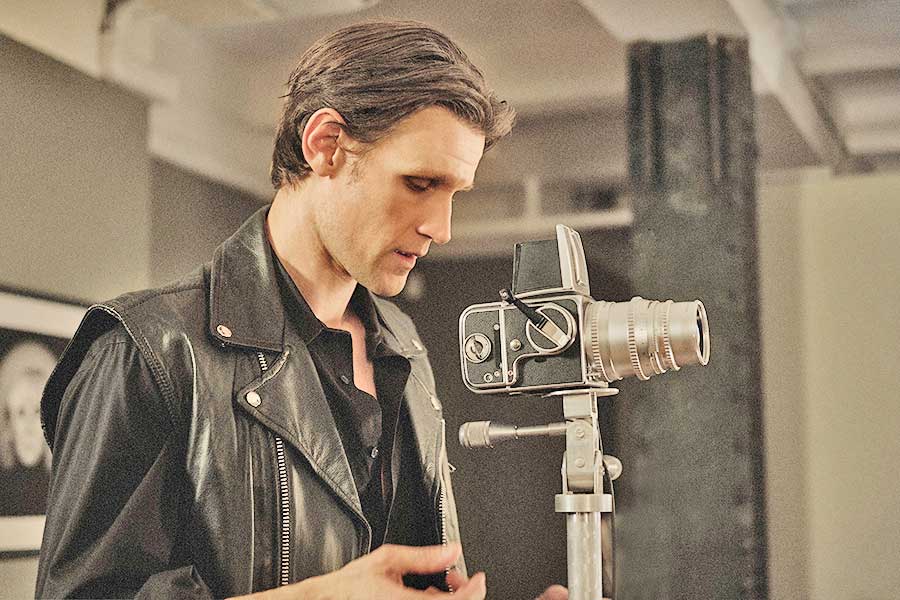If only Ondi Timoner’s ambitious biopic, “Mapplethorpe,” was as stimulating as the titular artist’s work.
This disappointing film, opening March 8 at Landmark’s Ritz at the Bourse, never quite captures his essence. There is more feeling and emotion in his images of calla lilies and penises — images graciously loaned from the artist’s foundation, and prominently featured throughout the film — than there is in the actual drama that unfolds.
Early on, Robert Mapplethorpe (Matt Smith) meets Patti Smith (Marianne Rendón) in the park. They move in together and struggle and support each other.
However, in dramatizing these moments, Timoner recounts facts that fail to illuminate either artist. (Smith’s musical aspirations are barely mentioned.) The pair acts more like roommates with benefits.
“Mapplethorpe” picks up 19 minutes in — yes, watch-checking was done — when Robert meets Sandy Daley (Tina Benko), a Chelsea Hotel neighbor who gives him a Polaroid camera and encourages him to take photos. Robert also begins exploring his sexual attraction to men. A photo shoot with David Croland (Thomas Philip O’Neill) shows Robert “making history,” as he says, by photographing David shirtless and with his wrists and mouth bound.
But rather than allow viewers to process these images, which are raw, sexy and scary, the film has Robert tell David that “beauty and the devil are sort of the same thing to me,” using his Catholicism to explain his fascination with taboos. Even Robert’s family priest (Brian Stokes Mitchell) later talks about the good and evil in the photographer’s work. These moments are as obvious and on-the-nose as Robert telling a gallerist that visual art should speak for itself, and that images should move viewers, provoke them and make them think. The film never allows viewers to think as it spoon-feeds them almost every point.
“Mapplethorpe” is never very moving or provocative. This all-too-conventional biopic takes too few chances. Although the artist’s daring photographs may elicit a gasp from viewers unfamiliar with his explicit work, the Robert in this film never comes off as someone who would take a self-portrait with a bullwhip in his ass. If that is Timoner’s point — that Mapplethorpe’s personal life plumbed depths as great as his art — it should have been heightened, not downplayed.
“Mapplethorpe” does flicker to life briefly when Sam Wagstaff (out gay actor John Benjamin Hickey) turns up and takes a shine to the “shy pornographer.” A scene — 39 minutes in — where Sam visits Robert’s studio bristles with some sexual tension. Robert sizes up Sam while Sam sizes up Robert’s talent. Their personal and professional relationship helps Robert’s career and helps him to sell photography as collectable art. Robert insists that gallerist Holly Solomon (Kerry Butler) show all of his work or none of it. And while it is clear Robert’s work sells, his critical impact in the art world is understated.
An hour in, “Mapplethorpe” cuts to 1981, with a montage featuring Ronald Reagan, Pac-Man and John McEnroe as Bronski Beat’s “Smalltown Boy” plays on the soundtrack. (Music is used as a crutch throughout the film; hear also T Rex’s “Children of the Revolution” to denote Mapplethorpe’s pornographic gallery show). It is in this chapter where Robert contrives to meet Milton Moore (McKinley Belcher 3d), an African-American man who becomes his muse and lover. Their relationship, however, is depicted in broad strokes. Milton’s criticisms of Robert’s inappropriate treatment of him in their personal relationship is discussed but never shown, thereby making it a one-sided argument where everyone loses.
In the film’s last 20 minutes, AIDS finally rears its ugly head. Both Sam and Robert contract the disease; the word “AIDS,” however, is deliberately never mentioned. But Robert’s shocking attitude about transmitting the disease through his behavior is — and it’s one of the few telling moments in the film.
There is more crammed into the 102 minutes of “Mapplethorpe,” including Robert’s complicated working relationship with his brother, Edward (Brandon Sklenar), which suggests Timoner bit off more than he could chew. Had the film focused on a specific period of the artist’s life — his relationship with Patti, or Sam, or post-success — it might have been stronger. Instead, bon mots such as Sam’s comment, “Sentimentality is the kiss of death in art,” or Robert’s thoughts about beauty and perfection giving solace, or his legacy, are meant to pass as profound. There is also considerable text at the end of the film, suggesting there’s more to the story than viewers see.
In the title role, Smith may resemble Mapplethorpe, particularly towards the end of his life, but he never quite brings the artist and his complexities to life. He acts haughty or bitchy as each scene requires, but it’s just posturing, not a really full-bodied performance.
Ultimately, “Mapplethorpe” feels like a missed opportunity.
